Theodore's Memorial Video
Wednesday, September 07, 2011
Book Review: Stanley Seagull, by Cathy Mazur
Disclaimer: I received a free copy of this book as a PDF file from the publisher, and I am receiving no compensation for writing this review. I thoroughly enjoyed reviewing this book.
Stanley Seagull
by Cathy Mazur
illustrated by Colleen Gedrich
Tribute Books
2011
Kurt Vonnegut allegedly said that any story can be simplified to the point that it is just another version of Shakespeare’s Hamlet. It might take a while to figure it out, but all the basic elements can be rooted out of any composition consisting of complete sentences organized into reasonably-sized paragraphs: dysfunctional family, character flaws, failed relationships, death, and ghosts. Consider the movie Top Gun as a good example of this concept. I disagree with the late Mr. Vonnegut, because he has overgeneralized when he said all stories are rewrites of Hamlet. The book I review today is not a variation on the theme of Hamlet, but is more than just a children's story. Stanley Seagull, written by Cathy Mazur and illustrated by Colleen Gedrich, is a delightful children’s book which my children enjoyed having read out loud to them. It does have an underlying theme which may not be obvious to the younger reader, but may interest the adult elocutionist.
In brief, Stanley is a seagull who lives somewhere along the northeast coast of the United States. I thought it was along the coast of New York or New Jersey, probably because Stanley hangs out on the boardwalk. Perhaps it is because I have fond childhood memories of visiting the Boardwalk in Atlantic City in the early 1970's. Stanley thinks only of food: where to get it, where to get more, how to get more. Even his relationships with other birds are dominated by the thought of eating and how to satisfy this one single desire. He obviously is an immature bird, as he has not been invited to feed at the choicest feeding grounds. When he does get invited there, he discovers that it is a dump, a landfill along the shore. He is warned to be careful and be ready to flee at a moment’s notice, but he forgets all caution as he gorges on the many delights spread before him. He ends up trapped in a garbage truck, which takes him far from the ocean. He ends up at a city dump, which looks a lot like the landfill he just left: there is plenty of food and seagulls, but it is colder, and there is no ocean. He misses the ocean.
He meets the other birds; one, named Walter, advises him to stay as the journey back to the ocean is too far. He tries to escape anyway. After flying for a while, he spots what he thinks is the ocean but is actually just the wet pavement of a parking lot. He returns to the garbage dump, dejected. Walter advises Stanley that the only way to return to the ocean is to make the return trip in one of the garbage trucks. It is difficult to sneak aboard, but Stanley accomplishes this. He completes the trip back to the ocean and is reunited with his friends, his cousin Seymor, and his beloved ocean.
For my younger children who sat with me while I read it aloud, this was a pleasant little book which kept them interested for a while. They liked the story as well as the illustrations which went along with it. As I looked over the book, I did start to notice a few themes which struck me, and I shall elaborate on each one briefly. Stanley is more than just a seagull when seen through the eye of metaphor and symbolism.
To begin with, I saw Stanley as a Christ figure. Consider that he enters a cave in which he falls into a deep sleep; this is reminiscent of Christ lying in the tomb after His death on the cross. He goes to a place which may be considered Hell, or Purgatory. The occupants he meets are physically taken care of, but they are separated from what is their true nature; namely, to be living near the sea. Stanley breaks out of this other place, once again having to enter the cave and falling into a deep sleep. He returns to his former, preferred life; he is resurrected from the dead, so to speak. What does not go along with Stanley as a Christ figure is that he does not come back to improve the life of the seagulls in either location; in fact, one would think that those birds representing the Just would be liberated from the city dump along with Stanley. Another problem is that Stanley receives more help than he gives to those in what one might consider Hell or Purgatory.
Two other characters in literature fit Stanley even better: Jonah and Pinocchio. All three characters end up in the hold of a vessel of sorts; for Jonah and Pinocchio, it is the belly of a large fish. For Stanley, his symbolic whale is the hold of a garbage truck. All three end up in this type of prison because of their fallen nature: Jonah disobeys God, Pinocchio is constantly getting into trouble, and Stanley fails to avoid danger while he is busy gorging himself. Finally, all three are chastised and learn, grow from the experience.
However, I think the literary figure Stanley resembles the most is actually Dante Alighieri in Purgatorio. In the Divine Comedy, Dante visits Purgatory and sees how the occupants are forced to perform penances which are related to their particular sin (or sins). In Stanley’s Purgatory, he realizes that his love for food has subordinated his love for self-preservation, and that this is how he ended up in the city dump. He must conquer his overwhelming love for food before he can be free again. He has to return to the garbage truck - his own cave - without enjoying any of the delights which are found within in order to find salvation. Helping Stanley discern his plight - and the solution – is Walter, a bespectacled and feathered rendition of Virgil, who is Dante’s guide through Purgatory. Without his explanation, Stanley would have pined away at the city dump for the rest of his life.
Another theme which is briefly explored is the concept of the protagonist coming of age in the story. Stanley is obviously an immature and inexperienced bird awaiting the opportunity to develop into an adult bird. The scene where Stanley watches Seymor steal a hot dog, and when Stanley is finally invited to feast at the landfill along the shoreline are metaphors for the child on the verge of manhood. Unfortunately, the story does not follow through with this theme after Stanley comes back from the city dump.
In conclusion, Stanley Seagull is a good read for adults as well as children. Whether the author intended to create a metaphor for Dante’s Purgatorio is debatable. What is not debatable is the comment my ten-year old son made about it. He liked the book simply because Stanley found his way back home.
Home.
Back home.
Perhaps it is really a rewrite of The Odyssey?
Stephen M. Donahue
September 7, 2011
My favorite picture from the book: Stanley flying over his beloved ocean. Illustrated by Colleen Gedrich.
More about this book:
Stanley Seagull web site:
http://www.stanleyseagull.com/
Tribute Books website:
http://www.tribute-books.com/
Book Summary:
Meet a young seagull named Stanley. Follow him as he wanders far from home and tries to find his way back. Join Stanley on his journey as he learns how humans affect the balance of nature.
Cathy Mazur's Bio:
Born in Scranton, Pa., Cathy Mazur is the daughter of Gary and Catherine H. Errico. She was educated in the Dunmore public school system and graduated from Dunmore High School in 1971. She received a bachelor’s degree in Library Science from Mansfield State College in 1975. She received a Reading Specialist Certificate from the University of Scranton in 1978. Cathy was employed as an elementary school librarian for the Mid Valley School District from 1975 until her retirement in 2010. While at Mid Valley, she instituted and coordinated the RIF (Reading Is Fundamental) program for 33 years helping students to develop a love of reading outside the classroom. Cathy served on the Board of Directors for the Valley Community Library in Peckville, Pa. for over 20 years acting as president for one year and board secretary for 19 years. She presently serves on the library’s Developmental Committee chairing various fundraising events. She resides in Dickson City, Pa. with Frank, her husband of 31 years. They are the parents of two children, Gary, 27 and Gia, 19. Now in her retirement, she is focused on writing books for children like Stanley Seagull.
Colleen Gedrich's Bio:
Colleen Gedrich, a lifelong resident Throop, Pa., earned a BFA in illustration from Marywood University in 2002. She is a freelance illustrator specializing in animal-themed work. She enjoys creating her art using mostly watercolor and pastel. As a dedicated animal rights activist and full-time program coordinator for International Society for Animal Rights (ISAR), Colleen lives her dream of joining her passions for animals and art to promote a more harmonious world with a touch of beauty. Recent works produced by Colleen include t-shirt and invitation designs, children’s book illustrations (A Different Kind of Hero), and book covers (With God There Is Hope). Colleen has also teamed up with her very talented artist mother, Kathy Holmes Gedrich, and paints murals for children’s nurseries.
Hardcover
Price: $16.95
ISBN: 9780983741817
Pages: 32
Release: July 2011
Paperback
Price: $7.95
ISBN: 9780983741800
Pages: 32
Release: July 2011
Subscribe to:
Post Comments (Atom)
Our Lady of the Mysterious Decapitation

Now restored with the help of some cement!
Prayer to Our Lady of the Mysterious Decapitation
Mary my mother, take my hand today, and all days.
Lead me away from all occasions of sin.
Guide me in fulfilling your last words in the Gospel,
"Do whatever He tells you."
Amen.
Lead me away from all occasions of sin.
Guide me in fulfilling your last words in the Gospel,
"Do whatever He tells you."
Amen.








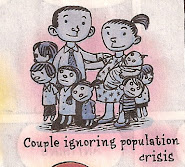
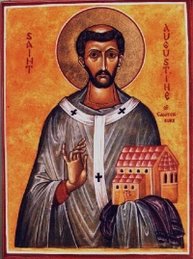



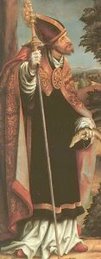
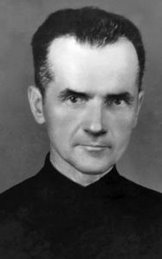

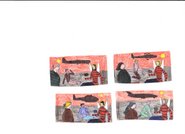


4 comments:
Stephen - wow! What an insightful review. I love the literary references peppered throughout especially Walter as the seagull version of Virgil. What a fascinating look at a children's picture book. Thank you for bringing such meaning and depth to your thoughts. It is much appreciated!
Stephen,thanks for the review and the insight.Working as a school librarian I would see seagulls sitting on our school's football field over 100 mi. from the ocean. A landfill sits less than one quarter of a mile from the school. I felt sorry for the these seabirds stuck in NE Pennsylvania.Walter was our older neighbor who gave my husband advice about work, life in general etc. I am flattered by your thouhts.
Stephen,thanks for the review and the insight.Working as a school librarian I would see seagulls sitting on our school's football field over 100 mi. from the ocean. A landfill sits less than one quarter of a mile from the school. I felt sorry for the these seabirds stuck in NE Pennsylvania.Walter was our older neighbor who gave my husband advice about work, life in general etc. I am flattered by your thouhts.
Thanks. I recall seagulls in the parking lot of a McDonald's in Ann Arbor, Michigan when I was a wee lad. Now I think I know why Walter had such distinct glasses.
Post a Comment